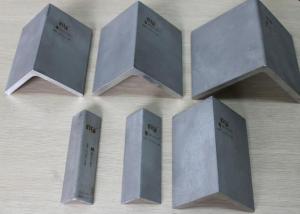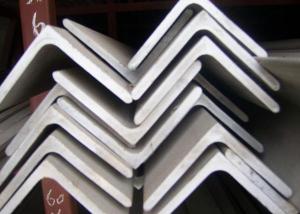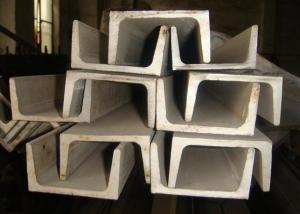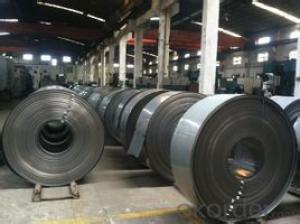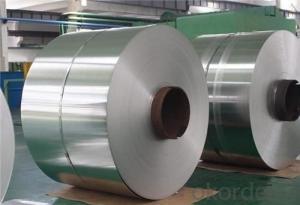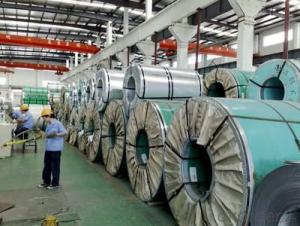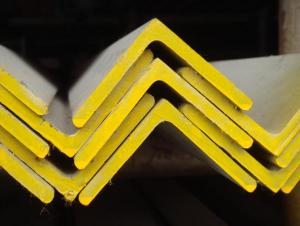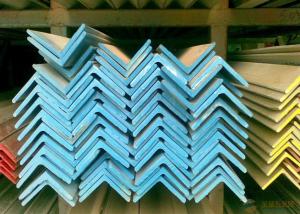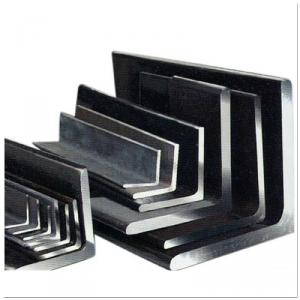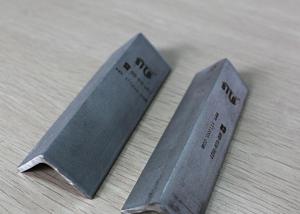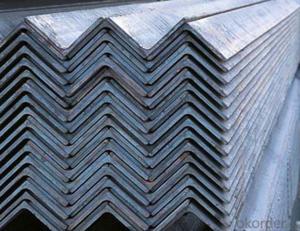Stainless Steel Angles SS200,300,400 Series
- Loading Port:
- China Main Port
- Payment Terms:
- TT or LC
- Min Order Qty:
- 1 Ton m.t.
- Supply Capability:
- 2000 Tons Per Month m.t./month
OKorder Service Pledge
OKorder Financial Service
You Might Also Like
Stainless Steel Angles
1.Grade: SS200,300,400 series
2.Size: 25×25×3 mm-100×100×10mm
3.Process: HRAP
4. Length: 2-6m
5. Shape: Equal
6. Delivery: within 20 days
7. MOQ: 1 ton
8. Certificate: ISO 9001:2008, SGS
9. Package:Standard Export Packing, or put into wooden boxes according to your
requirement
10. Application: Construction, Marine, Industry and so on
Name | Stainless Steel Angles | ||||||
Standard | ASTM A554, A312, A249, A269 and A270 | ||||||
Material Grade | 304,316,201,202, 316L,430 | ||||||
Length | 6m or as customers' request | ||||||
Tolerance | a) thickness: +/-0. 15mm | ||||||
| |||||||
b) Length:+/-4. 5mm - 0mm | |||||||
Surface | 180G, 320G, 400G Satin / Hairline(Matt Finish, Brush, Dull Finish) 400G, 500G, 600G or 800G Mirror finish | ||||||
Application | Decoration construction, upholstery, industry instruments | ||||||
Test | Squash test, Extended test, Water pressure test, Crystal rot test, Heat treatment, NDT | ||||||
Chemical Composition of Material |
Composition
Material | 201 | 202 | 304 | 316L | 430 | |
C | ≤0.15 | ≤0.15 | ≤0.08 | ≤0.08 | ≤0.12 | ||
Si | ≤1.00 | ≤1.00 | ≤1.00 | ≤1.00 | ≤1.00 | ||
Mn | 5.5-7.5 | 7.5-10 | ≤2.00 | ≤2.00 | ≤1.00 | ||
P | ≤0.06 | ≤0.06 | ≤0.045 | ≤0.045 | ≤0.040 | ||
S | ≤0.03 | ≤0.03 | ≤0.030 | ≤0.030 | ≤0.030 | ||
Cr | 16-18 | 17-19 | 18-20 | 16-18 | 16-18 | ||
Ni | 3.5-5.5 | 4-6 | 8-10.5 | 10-14 |
| ||
Mo |
|
|
| 2.0-3.0 |
| ||
Mechanical Property | Material Item | 201 | 202 | 304 | 316L | ||
Tensile Strength | ≥535 | ≥520 | ≥520 | ≥520 | |||
Yield Strength | ≥245 | ≥205 | ≥205 | ≥205 | |||
Extension | ≥30% | ≥30% | ≥35% | ≥35% | |||
Hardness (HV) | <253 | <253 | <200 | <200 | |||
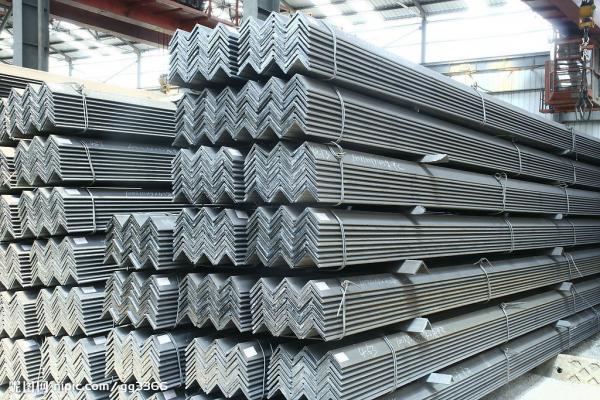

- Q:What are the design considerations when using stainless steel angles?
- When using stainless steel angles, there are several design considerations that need to be taken into account. Firstly, it is important to consider the load-bearing capacity of the stainless steel angles. Stainless steel is known for its high strength and durability, but the specific grade and thickness of the angles should be chosen based on the expected load and stress on the structure. This will ensure that the angles can support the intended weight without deformation or failure. Another important consideration is corrosion resistance. Stainless steel is highly resistant to corrosion, but the type of environment in which the angles will be exposed should be taken into account. For example, if the angles will be used outdoors or in highly corrosive environments such as near seawater or chemical plants, a more corrosion-resistant grade of stainless steel should be used. Additionally, proper maintenance and cleaning procedures should be implemented to prevent corrosion and maintain the integrity of the angles over time. The aesthetics of the stainless steel angles should also be considered. Stainless steel has a sleek and modern appearance, making it a popular choice in architectural and design applications. The angles can be polished or brushed to achieve different finishes, and their clean lines and smooth surfaces can enhance the overall visual appeal of a structure. Furthermore, it is essential to consider the fabrication and installation process when designing with stainless steel angles. Stainless steel can be easily cut, welded, and formed to meet specific design requirements. However, it is important to work with experienced fabricators and installers who are familiar with the properties and characteristics of stainless steel to ensure proper handling and installation. This will help avoid any issues related to distortion, warping, or damage during fabrication or installation. Lastly, cost is an important consideration when using stainless steel angles. Stainless steel is generally more expensive than other materials such as carbon steel or aluminum. Therefore, it is crucial to carefully evaluate the project's budget and weigh the benefits and drawbacks of using stainless steel angles in comparison to other available options. In conclusion, when using stainless steel angles in a design, it is important to consider factors such as load-bearing capacity, corrosion resistance, aesthetics, fabrication and installation, and cost. By carefully evaluating these design considerations, one can ensure the successful integration of stainless steel angles into a wide range of applications.
- Q:Can stainless steel angles be used in transportation infrastructure?
- Transportation infrastructure can indeed utilize stainless steel angles. Stainless steel possesses excellent corrosion resistance, durability, and strength, rendering it suitable for diverse transportation infrastructure applications. Bridges, railway tracks, highways, airports, and other transportation facilities can all incorporate stainless steel angles within their construction. The resistance to corrosion provided by stainless steel angles is a primary advantage for transportation infrastructure. This resistance arises from the presence of chromium within stainless steel, which generates a protective oxide layer on the surface. Consequently, stainless steel angles can withstand rust and corrosion caused by exposure to moisture, chemicals, and extreme weather conditions. By ensuring longevity and durability, this corrosion resistance reduces maintenance costs and enhances safety. Additionally, stainless steel angles offer a high strength-to-weight ratio, making them ideal for structural purposes. They can bear heavy loads and contribute to structural stability, thereby improving the safety and reliability of transportation infrastructure. Moreover, stainless steel angles exhibit exceptional resistance to fire and extreme temperatures, further enhancing their suitability for transportation applications. In addition to their mechanical properties, stainless steel angles possess an aesthetic appeal that plays a crucial role in transportation infrastructure projects. Their appearance can be enhanced through polishing, brushing, or coating, thereby improving the visual appeal of bridges, railings, and other transportation structures. Furthermore, stainless steel qualifies as an environmentally friendly material. Being 100% recyclable, it aligns with sustainability goals in transportation infrastructure projects. Utilizing stainless steel angles promotes a circular economy by reducing the demand for new raw materials and minimizing waste. All in all, stainless steel angles offer a plethora of advantages, rendering them suitable for transportation infrastructure applications. Their corrosion resistance, durability, strength, aesthetic appeal, and environmental benefits make them a viable choice for various applications within this sector.
- Q:What are the different types of stainless steel angles profiles?
- There are several different types of stainless steel angle profiles available, each with their own unique characteristics and applications. Some of the most common types include: 1. Equal Leg Angle: This type of stainless steel angle has equal dimensions on both legs, making it ideal for applications where symmetry is important. It is commonly used in structural applications, such as construction and fabrication projects. 2. Unequal Leg Angle: As the name suggests, this type of stainless steel angle has unequal dimensions on its legs. It is often used in applications where one leg needs to be longer or shorter than the other, such as framing or bracing. 3. L-Shaped Angle: This profile features a 90-degree angle, forming an L-shape. It is commonly used in corners or as a support for shelves, cabinets, or countertops. 4. Rounded Edge Angle: This type of stainless steel angle has rounded edges instead of sharp corners. It is often used in applications where safety is a concern, such as playground equipment or handrails. 5. Slotted Angle: Slotted stainless steel angles have holes or slots along their length, allowing for easy attachment and adjustment. They are frequently used in shelving systems, racks, or framework where flexibility and adjustability are crucial. 6. Decorative Angle: These angles are designed to enhance the aesthetic appeal of a space. They come in various patterns and finishes, making them suitable for architectural or interior design purposes. It's worth noting that these are just a few examples of the many stainless steel angle profiles available. The specific type of angle profile chosen depends on the intended use, load-bearing requirements, and aesthetic preferences of the project.
- Q:Can stainless steel angles be used in the production of electronic components?
- Yes, stainless steel angles can be used in the production of electronic components. Stainless steel is known for its durability, corrosion resistance, and high-temperature strength, making it suitable for various applications in the electronics industry. Stainless steel angles can be used for structural support, housing components, connectors, and other parts where strength and resistance to environmental factors are essential.
- Q:What are the fatigue resistance properties of stainless steel angles?
- Stainless steel angles possess remarkable fatigue resistance characteristics. With their remarkable strength and durability, stainless steel angles can endure repeated loading and cyclic stress without encountering substantial fatigue failure. This is primarily due to the distinctive composition of stainless steel, which incorporates a significant amount of chromium, nickel, and other alloying elements that enhance its corrosion resistance and mechanical properties. Furthermore, stainless steel angles are frequently subjected to heat treatment, which further enhances their fatigue resistance. As a result of these properties, stainless steel angles are highly favored in applications where cyclic loading and fatigue are significant concerns, such as structural components in buildings, bridges, and machinery.
- Q:Are stainless steel angles resistant to oxidation?
- Yes, stainless steel angles are highly resistant to oxidation due to the chromium content in the alloy which forms a protective layer on the surface, preventing rust and corrosion.
- Q:What are the different surface treatments available for stainless steel angles?
- There are several different surface treatments available for stainless steel angles, each providing unique benefits and characteristics. 1. Polishing: This treatment involves removing any roughness or imperfections on the surface of the stainless steel angle, resulting in a smooth and shiny finish. Polished stainless steel angles are often used in applications where aesthetics and visual appeal are important, such as architectural or decorative projects. 2. Brushing: Brushing involves creating a textured finish on the surface of the stainless steel angle by using abrasive materials or brushes. This treatment gives the angle a distinctive linear pattern, providing a visually interesting and durable finish. Brushed stainless steel angles are commonly used in applications where a more industrial or modern look is desired. 3. Electropolishing: Electropolishing is an electrochemical process that removes a thin layer of material from the surface of stainless steel angles, resulting in a smooth, clean, and corrosion-resistant finish. This treatment enhances the natural corrosion resistance of stainless steel and improves its appearance by eliminating surface imperfections. 4. Passivation: Passivation involves treating the surface of stainless steel angles with a chemical solution to remove any iron contamination or embedded particles. This process helps to restore the corrosion resistance of the stainless steel and create a passive oxide layer on the surface, protecting it from further oxidation or corrosion. 5. Coating: Stainless steel angles can also be coated with various materials to provide additional protection or alter their appearance. Common coating options include powder coating, which provides a durable and decorative finish, and PVD (Physical Vapor Deposition) coating, which creates a thin, hard, and decorative layer on the surface of the angle. The choice of surface treatment for stainless steel angles depends on the specific application requirements, including factors such as aesthetics, corrosion resistance, and durability. It is important to consider the intended use and environment of the angles to select the most suitable surface treatment that will meet the desired performance and appearance goals.
- Q:What is the cost of stainless steel angle?
- The cost of stainless steel angle can vary depending on factors such as size, thickness, and quantity. It is best to contact a supplier or check online for current pricing.
- Q:Can stainless steel angles be used for conveyor systems?
- Yes, stainless steel angles can be used for conveyor systems. Stainless steel is a common material used in conveyor systems due to its durability, corrosion resistance, and ability to withstand high temperatures. Stainless steel angles are often used for support and structural purposes in conveyor systems, providing stability and strength to the overall structure. Additionally, stainless steel's smooth surface makes it ideal for clean environments, such as food processing or pharmaceutical industries, where cleanliness and hygiene are crucial. Overall, stainless steel angles are a suitable choice for conveyor systems due to their strength, corrosion resistance, and compatibility with various industries.
- Q:What are the toughness properties of stainless steel angles?
- Stainless steel angles possess excellent toughness properties due to their unique composition and manufacturing process. The main factor contributing to their toughness is the presence of chromium, which forms a protective passive layer on the surface of the steel. This layer prevents corrosion, enhancing the material's durability and resistance to damage. Stainless steel angles also exhibit high strength, making them capable of withstanding heavy loads and impacts without fracturing or breaking. They have a high tensile strength, meaning they can resist pulling forces, and a high yield strength, allowing them to withstand bending or deformation without permanent damage. Furthermore, stainless steel angles have good impact resistance, which means they can absorb and distribute energy efficiently, reducing the risk of fractures or cracks. This property is particularly important in applications where the angles are subjected to dynamic loads or vibrations. Another aspect of toughness in stainless steel angles is their resistance to temperature extremes. They maintain their strength and toughness even at high temperatures, making them suitable for various industrial and structural applications, including in environments with fluctuating temperatures. In summary, stainless steel angles possess excellent toughness properties due to their corrosion resistance, high strength, impact resistance, and ability to withstand temperature extremes. These qualities make them a reliable and durable choice for a wide range of applications, including construction, manufacturing, and engineering projects.
1. Manufacturer Overview |
|
|---|---|
| Location | Zhejiang, China |
| Year Established | 2010 |
| Annual Output Value | above US$16 million |
| Main Markets | East Asia, Middle East. |
| Company Certifications | |
2. Manufacturer Certificates |
|
|---|---|
| a) Certification Name | |
| Range | |
| Reference | |
| Validity Period | |
3. Manufacturer Capability |
|
|---|---|
| a)Trade Capacity | |
| Nearest Port | Shanghai |
| Export Percentage | |
| No.of Employees in Trade Department | above 10 people |
| Language Spoken: | English, Chinese |
| b)Factory Information | |
| Factory Size: | about 30000 square meter |
| No. of Production Lines | above 7 |
| Contract Manufacturing | OEM Service Offered |
| Product Price Range | Average |
Send your message to us
Stainless Steel Angles SS200,300,400 Series
- Loading Port:
- China Main Port
- Payment Terms:
- TT or LC
- Min Order Qty:
- 1 Ton m.t.
- Supply Capability:
- 2000 Tons Per Month m.t./month
OKorder Service Pledge
OKorder Financial Service
Similar products
New products
Hot products
Hot Searches
Related keywords
